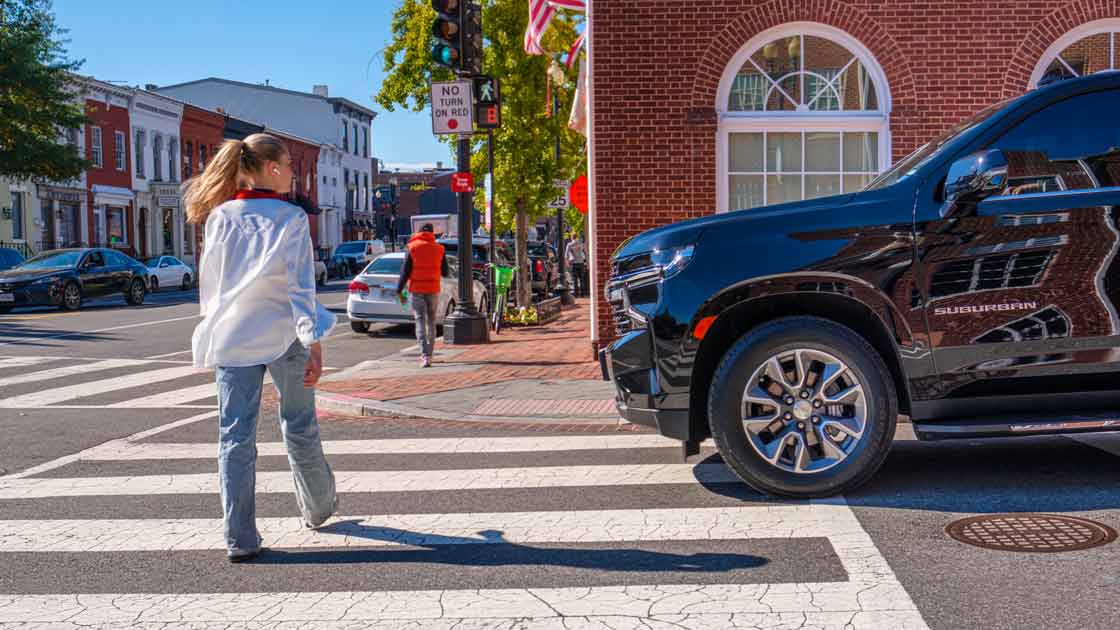Insight
Designers must make vehicles safe for everyone — not just drivers and passengers
June 20, 2024

A version of this article appeared in Dangerous by Design 2024, a report on pedestrian risks throughout the U.S. published by Smart Growth America.
Designing for walkability is not just about roads. The design of vehicles — everything from their size and shape to their software — has a profound effect on the safety of pedestrians, cyclists, and other road users. Through our research and testing programs, IIHS is identifying vehicle improvements that can work in conjunction with infrastructure and enforcement changes to produce a safer transportation system for all.
When it comes to vehicle size and shape, it’s long been known that SUVs, pickups, and light vans are more likely to kill or seriously injure pedestrians and cyclists when involved in a crash compared with sedans. SUVs have taken over U.S. roads, climbing from 24% of registered vehicles in 2013 to 36% in 2023. Recent research from IIHS demonstrates that the height and shape of their front ends is part of what makes them dangerous. We found that passenger vehicles with front ends more than 40 inches off the ground and vehicles with blunt front ends between 30 and 40 inches high were more likely to kill pedestrians than vehicles with shorter hood heights and more sloping front-end profiles. The National Highway Traffic Safety Administration recently proposed a program to test vehicles on how well they protect pedestrians, but it would not account for the outsize role larger vehicles play in U.S. pedestrian fatalities.
Poor visibility is another possible factor in the danger larger vehicles pose to pedestrians. We found that SUVs, pickups, and light vans are more likely than sedans to hit pedestrians at intersections while turning. It’s possible that structures like the A-pillar or side mirror, especially large ones, make it harder for drivers to see a crossing pedestrian. We are conducting research now to see if poor visibility explains why larger vehicles are overrepresented in turning crashes.
Vehicle design trends are not all bad news. Since 2019, IIHS has been rating pedestrian crash avoidance systems, which warn the driver when a pedestrian is detected and apply the brakes if the driver doesn’t respond in time. We have found that this technology reduces pedestrian crash rates by 27%; even when it doesn’t prevent a crash, it can reduce the severity of the pedestrian’s injuries by lowering the impact speed. More and more vehicles are being sold with this technology standard, and NHTSA recently mandated it on new vehicles starting in 2029. Crash prevention systems that detect cyclists are not as prevalent, but they hold promise. And although headlights are not a new technology, IIHS has been evaluating the quality of vehicle headlights since 2016 and found that the percentage of headlights that received a good rating for increasing roadway visibility went up from 1% in 2016 to 42% in 2023. Vehicles with headlights that receive a good rating in IIHS tests have nighttime crash rates with pedestrians that are 23% lower than vehicles with headlights that are rated poor.
Controlling speed is essential for preventing serious injuries to pedestrians and cyclists. Intelligent speed assistance (ISA) is an emerging vehicle technology that can help drivers slow down. ISA uses cameras to read speed limit signs or integrates maps of speed limits with GPS. Some systems warn the driver when they exceed the speed limit, while others limit power to the engine to keep them from doing so. Many new passenger vehicles today are equipped with speed limit warnings. Active forms of ISA are being trialed by municipal fleets. New York City, for example, has installed the technology on 300 city-owned vehicles and plans to equip 1,700 more. Lawmakers in California are considering a bill that would require ISA that warns drivers when they are speeding 10 mph over the limit on all new vehicles. A new law in Washington, DC, requires active ISA for offenders with a history of excessive speeding; New York lawmakers are considering a bill to do the same.
As important as vehicle design improvements and technology are, we can’t rely on them alone to improve safety for nonmotorists. It can take decades after a new safety feature is introduced for it to be present on nearly every car on the road. Moreover, even advanced technology will not prevent every crash, which means that safe infrastructure will always be needed. Setting and enforcing safe speed limits, designing roads to require drivers to choose safe speeds, modifying intersections and crosswalks to increase pedestrian visibility and driver awareness, and increasing the separation between pedestrians and cyclists from motor vehicle traffic are needed now to fill that gap.
Improvements to roadway design can mitigate the negative effects of increasing vehicle size. An SUV, pickup or light van traveling at a lower speed will be less likely to seriously injure or kill a pedestrian or cyclist. Street design changes that reduce speeds of left-turning vehicles at intersections (through left-turn traffic calming treatments) or right-turning vehicles (through a decreased corner radius) can similarly reduce the severity of turning crashes. Strategies such as removing parking near intersections, a practice known as “daylighting”, and leading pedestrian intervals, which allow pedestrians to enter crosswalks at intersections before vehicles are given a green light, can enhance pedestrian visibility for drivers of all vehicle types.
The design of the environment is also key to allowing vehicle technology to function optimally. Some pedestrian crash prevention systems don’t work well at higher speeds, so measures to rein in high vehicle speeds can help these systems function at their best. In addition, roadway lighting makes pedestrians easier to see for drivers and pedestrian crash prevention systems alike. IIHS research found that pedestrian crash prevention systems don’t work well in the dark, which is why we started testing these systems at night in 2022. However, our crash research showed that these systems did work at night when street lighting was present. We are currently investigating if crosswalk lighting improves performance on the test track.
Design that accounts for human vulnerabilities and can accommodate mistakes made by drivers and other road users is the backbone of a safe system. Making this country safe for walking and cycling will require ongoing commitment and investment from those who design our roadways and those who design our vehicles.
